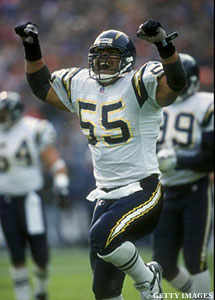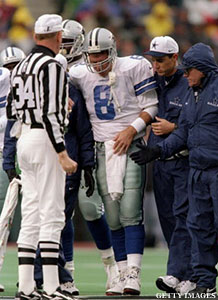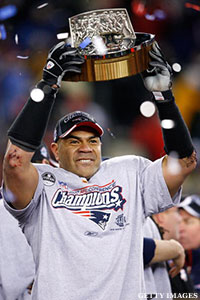
The apparently self-inflicted death of legendary NFL linebacker Junior Seau has sent a shock wave throughout the world of sports. Seau played professional football for 19 years for the Chargers, Dolphins and Patriots and was a 12-time Pro Bowl selection. His flamboyant playing style and jolting hits electrified fans for years. He was 43 years old.
This is a time for grief and remembrance. Seau was an integral part of the San Diego community and dedicated time and effort to his charitable foundation. His family needs prayers and support.
Normally, speculation as to causation would be premature, but these are not normal times. The spectre of head injury and the disastrous lifetime ramifications call for emphatic action. There is a largely undiagnosed health epidemic that has surrounded contact sports at the youth sports, high school, collegiate and professional level, and it is a ticking time bomb.
For many years a veil of denial has obscured the reality of what the long-term impact of multiple concussions portend. I first became concerned in the late 80's and 90's when I represented half the starting quarterbacks in the National Football League. As I went with clients like Troy Aikman and Steve Young to post-concussion visits with neurologists there were too many unanswered questions. How many head injuries is too many? What are the long term ramifications? How long should a player sit out after suffering the hit? Physicians had few concrete answers, the brain was the last frontier of medical research.
I finally decided that I could not in good conscience represent players in a sport that we intuitively knew could cause devastating consequences to the mental faculties of athletes, without becoming an active crusader to raise awareness of the danger. I felt like an "enabler" facilitating a "meat grinder" career.

In the 90's we held three concussion conferences in Newport Beach with the leading neurologists, helmet manufacturers, playing surface representatives talking to Steve, Troy, Warren Moon, Drew Bledsoe and many other clients. We issued a white paper calling for a standardized regimen of diagnosis and "return to play protocols." We urged better helmetry and protective devices. We asked for a neurologist to be put on the sideline and that the head and neck be banned from blocking and tackling. Not much changed.
The players themselves were in a state of denial concerning physical health. They had been taught from Pop Warner on to ignore pain, hide injury so as to not lose their starting position or jeopardize their status on the team. They didn't want to be known as "training room" players and be stigmatized and isolated from their peers. They were young men and athletes, two categories that viewed long-term health as an abstraction.
The most critical priority for them was the next play. And retired athletes were stoic and didn't talk about impaired memory or depression to younger players. In some cases, because concussion is not visible like a leg injury, they may not have known.
In conjunction with the Los Angeles-based Concussion Institute we helped facilitate another series of Concussion Seminars seven years ago. This time there was concrete data presented by researchers like Dr. Julian Bailes, Dr. Robert Cantu, Kevin Gusciewicz and Dr. Robert Hovda that seemed to indicate that three was the "magic number." Three or more concussions apparently raised exponentially the post-career risk of dementia, Parkinson's and depression.
Presentations were made about the existence of a genotype -- an allele of which produced heightened risk of concussion and severe post-concussion consequences. A pattern developed in which the repetitive head injuries produced chronic traumatic encephalopathy, permanent brain damage. Players like the Bears' Dave Duerson developed depression. Often loss of job and family would occur. And in some cases, suicide.
To their credit, Commissioner Roger Goodell and the NFL responded by convening a physician's conference. They issued a whistle-blower edict that urged player's to report other impaired players. And they adopted baseline testing, developed by Dr. Mark Lovell.

A cognivitive test is given prior to a season and in the case of concussion is followed by a second test. This is an objective way to measure the degree of damage and insure that players are asymptomatic at rest, on an excercise bike, and at practice before they are cleared to play. This is something that every parent should insist on for their "collision sport" children. Pro football may be most visible, but the risk is present in many other sports and at the collegiate, high school and youth levels. The adolescent brain may take three times as long to recover and it is still in formation.
The physics of collision have changed -- bigger,stronger, faster athletes colliding with a stationary object. And so the problem will accelerate and not diminish. The simple act of offensive and defensive lineman colliding thousands of times produces a low level concussive event. What will the cumulative effect of the injury mean for athletes in their forties and fifties?
I knew Junior Seau since the day he and his massive Samoan friends partied back stage as he was drafted in New York City. I represented him for a time. I love sports, but love the individuals who play them more. As Peter, Paul and Mary sang, "How many deaths will it take till we know that too many people have died?" We need to find the answers. They can't just be "blowin' in the wind."
-- Leigh Steinberg has represented many of the most successful athletes and coaches in football, basketball, baseball, hockey, boxing and golf, including the first overall pick in the NFL draft an unprecedented eight times, among more than 60 first-round selections. His clients have included Hall of Fame quarterbacks Steve Young, Troy Aikman and Warren Moon, and he served as the inspiration for the movie "Jerry Maguire." Follow him on Twitter @SteinbergSports.
Popular Stories On ThePostGame:
-- Concussion Issue Cannot Be Emphasized Enough, Especially For Youths
-- The Case Against The NFL
-- Brain Trauma And The Future Of Youth Football In America
-- Sports Can Be Leader In Climate Change Campaign




